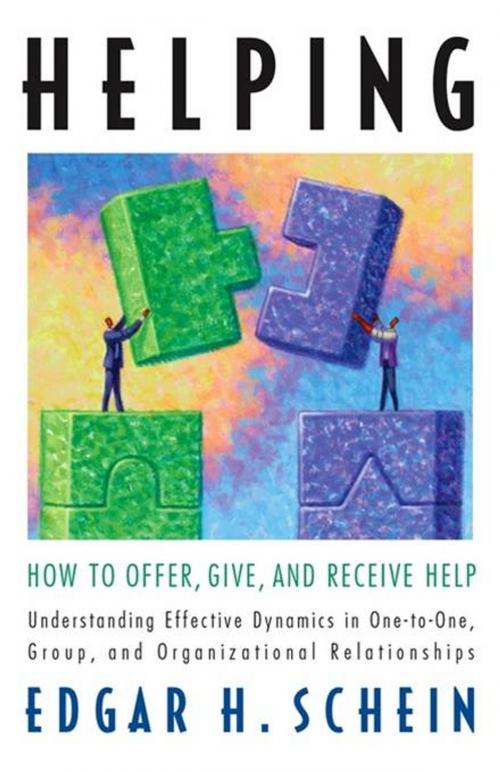Helping
How to Offer, Give, and Receive Help
Business & Finance, Human Resources & Personnel Management, Organizational Behavior| Author: | Edgar Schein | ISBN: | 9781605098807 |
| Publisher: | Berrett-Koehler Publishers | Publication: | February 1, 2009 |
| Imprint: | Berrett-Koehler Publishers | Language: | English |
| Author: | Edgar Schein |
| ISBN: | 9781605098807 |
| Publisher: | Berrett-Koehler Publishers |
| Publication: | February 1, 2009 |
| Imprint: | Berrett-Koehler Publishers |
| Language: | English |
By the bestselling author of Career Anchors (over 431,000 copies sold) and Organizational Culture and Leadership (over 153,000 sold) • A penetrating analysis of the psychological and social dynamics of helping relationships • Named one of the best leadership books of 2009 by strategy+business magazine Helping is a fundamental human activity, but it can also be a frustrating one. All too often, to our bewilderment, our sincere offers of help are resented, resisted, or refused—and we often react the same way when people try to help us. Why is it so difficult to provide or accept help? How can we make the whole process easier? Many different words are used for helping: assisting, aiding, advising, caregiving, coaching, consulting, counseling, guiding, mentoring, supporting, teaching, and many more. In this seminal book on the topic, corporate culture and organizational development guru Ed Schein analyzes the social and psychological dynamics common to all types of helping relationships, explains why help is often not helpful, and shows what any would-be helpers must do to ensure that their assistance is both welcomed and genuinely useful. The moment of asking for and offering help is a delicate and complex one, fraught with inequities and ambiguities. Schein helps us navigate that moment so we avoid potential pitfalls, mitigate power imbalances, and establish a solid foundation of trust. He identifies three roles a helper can play, explaining which one is nearly always the best starting point if we are to provide truly effective help. So that readers can determine exactly what kind of help is needed, he describes an inquiry process that puts the helper and the client on an equal footing, encouraging the client to open up and engage and giving the helper much better information to work with. And he shows how these techniques can be applied to teamwork and to organizational leadership. Illustrated with examples from many types of relationships—husbands and wives, doctors and patients, consultants and clients—Helping is a concise, definitive analysis of what it takes to establish successful, mutually satisfying helping relationships.
By the bestselling author of Career Anchors (over 431,000 copies sold) and Organizational Culture and Leadership (over 153,000 sold) • A penetrating analysis of the psychological and social dynamics of helping relationships • Named one of the best leadership books of 2009 by strategy+business magazine Helping is a fundamental human activity, but it can also be a frustrating one. All too often, to our bewilderment, our sincere offers of help are resented, resisted, or refused—and we often react the same way when people try to help us. Why is it so difficult to provide or accept help? How can we make the whole process easier? Many different words are used for helping: assisting, aiding, advising, caregiving, coaching, consulting, counseling, guiding, mentoring, supporting, teaching, and many more. In this seminal book on the topic, corporate culture and organizational development guru Ed Schein analyzes the social and psychological dynamics common to all types of helping relationships, explains why help is often not helpful, and shows what any would-be helpers must do to ensure that their assistance is both welcomed and genuinely useful. The moment of asking for and offering help is a delicate and complex one, fraught with inequities and ambiguities. Schein helps us navigate that moment so we avoid potential pitfalls, mitigate power imbalances, and establish a solid foundation of trust. He identifies three roles a helper can play, explaining which one is nearly always the best starting point if we are to provide truly effective help. So that readers can determine exactly what kind of help is needed, he describes an inquiry process that puts the helper and the client on an equal footing, encouraging the client to open up and engage and giving the helper much better information to work with. And he shows how these techniques can be applied to teamwork and to organizational leadership. Illustrated with examples from many types of relationships—husbands and wives, doctors and patients, consultants and clients—Helping is a concise, definitive analysis of what it takes to establish successful, mutually satisfying helping relationships.















